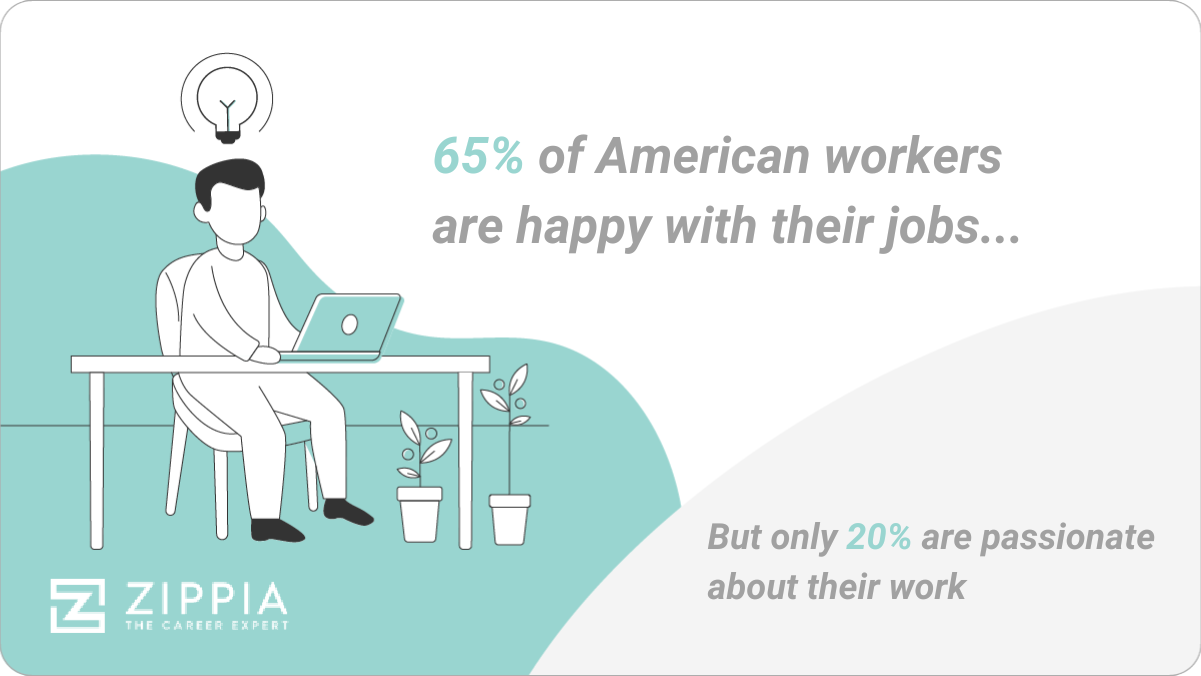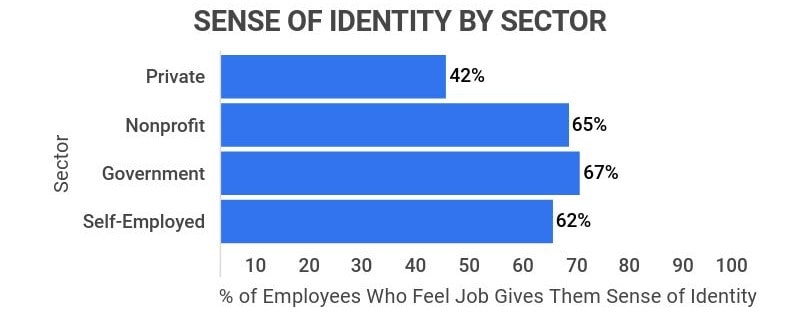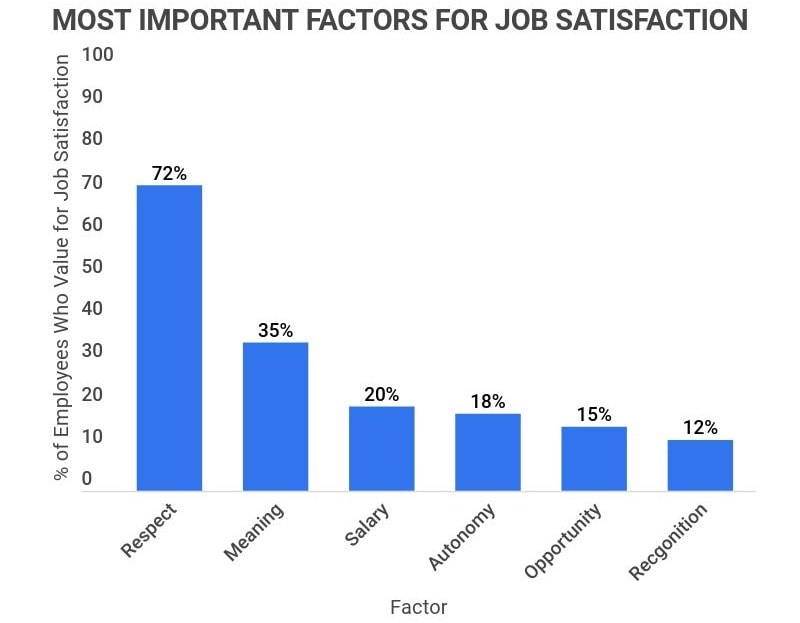- Workplace Statistics
- Time Management Statistics
- Employee Wellness Statistics
- Employment Discrimination Statistics
- Employee Recognition Statistics
- Employee Referral Statistics
- Workplace Violence Statistics
- Gamification Statistics
- Employee Feedback Statistics
- Agile Statistics
- Productivity Statistics
- Meeting Statistics
- Cell Phones At Work Statistics
- Social Media At Work Statistics
- Workplace Injury Statistics
- Workplace Stress Statistics
- Leadership Statistics
- Workplace Collaboration Statistics
- Job Satisfaction Statistics
- Paid Holiday Statistics
- Communication In The Workplace Statistics
- Wasting Time At Work Statistics
- 4-day Workweek Statistics
Job satisfaction research summary. With millions of people looking for new jobs in the wake of a shaken economy, it may be surprising to hear that most Americans are satisfied with their work.
However, there is also a crucial difference between having satisfaction in your work, and being passionate about your work. So, to find out more about how American job satisfaction, this article will address everything you need to know about job satisfaction.
After extensive research, our data analysis team concluded:
-
65% of U.S. workers are happy with their job.
-
But only 20% are passionate about their jobs.
-
Likewise, only 49% of American workers report being “very satisfied with their work,” while 30% are merely “somewhat satisfied.”
-
Over 100 million U.S. workers are at least somewhat satisfied with their work.
-
The top reason Americans are unsatisfied with their jobs is income — only 28% of those making less than $24,000 annually say they’re in good jobs.
-
Remote workers report higher levels of job satisfaction than in-office workers, at a difference of 57% to 50%.
-
61% of American employees want to leave their current jobs in 2023.
For further analysis, we broke down the data in the following ways:
Company | Age | Compensation | Productivity | Factors

Job satisfaction by profession
Job satisfaction isn’t just impacted by income, as the type of job someone has can also have a major impact on their job satisfaction. Despite lower incomes, many jobs in public service or humanities have high satisfaction rates. These rates seem at least somewhat linked with Americans finding “meaning” in their work. Here’s the breakdown:
-
Only 20% of Americans describe themselves as being truly passionate about their work.
Despite job satisfaction rates, there’s a lack of workplace passion in the U.S.
That’s why businesses are investing now more than ever to reach job seekers who are passionate about what they do, and truly want to work for them.
-
The jobs that employees consider most meaningful are often in Healthcare or Humanities.
Positions where over 90% of employees report high meaning: Clergy, English Language and Literature Teacher, Surgeons, Elementary Education Administrators, Radiation Therapists, Chiropractors. Psychiatrists, Anesthesiologists, Rehabilitation Counselors, Occupational Therapists, Kindergarten Teachers, and Epidemiologists.
-
The two main factors for high job satisfaction are “high meaning” and income.
All of the jobs with high job satisfaction provide either a high salary or high meaning.
Here are all of the jobs where over 85% of employees report job satisfaction: Clergy, Education Administrators, Radiation Therapists, Pediatricians, Cartographers and Photogrammetrists, Rotary Drill Operators, Emergency Management Specialists, and Chief Executives.
-
Pediatricians and chief executives are likely to receive satisfaction from income.
Though several other jobs have greater high meaning rates than Pediatricians (88%) and Chief Executives (74%), they still have job satisfaction rates higher than 85%.
This can likely be attributed to higher than average incomes, with Pediatricians making $149,000 per year and Chief Executives $126,000.
-
Those in the clergy have the highest rate of job satisfaction (90%).
Higher meaning really pays off for those in this position, as 90% of employees report having job satisfaction.
-
1/3 of people who make less than $25,000 have a job satisfaction rate below 50%.
Low income can cause less job satisfaction. Those who make less than $25,000 per year tend to report lower job satisfaction rates, with over 1/3 of jobs in this category having job satisfaction rates below 50%.
These are the jobs with lower incomes that have job satisfaction rates of 50% or less: Hand Packers and Packagers, Fast Food Cooks, Cashiers, Photographic Processing Machine Operators, Short Order Cooks, Parking Lot Attendants, Dishwashers, Cafeteria Attendants, and Dry-Cleaning Workers.
-
Employees dislike having a lack of meaning.
Of the positions where less than 30% of employees report their job having high meaning, very few have job satisfaction rates above 70%. In fact, out of the 22 jobs with high meaning rates of less than 30%, 16 of them report job satisfaction levels below 60%.
-
Parking lot attendants have it rough.
With an average income of only $19,700 and high meaning rates of only 5%, it’s no surprise that Parking Lot Attendants have a meager job satisfaction rating of 41%.
-
Cafeteria attendants and dry-cleaning workers have the lowest levels of job satisfaction.
Both of these jobs have an incredibly low job satisfaction rate of only 39%.
Job satisfaction by company
Job satisfaction is also affected by the type of company an employee works at. Here’s what we found in regards to job satisfaction as it relates to companies:
-
Organizational culture impacts job satisfaction by 42%.
A company’s mission and culture have a considerable impact on satisfaction rates. According to a study performed on 64 employees at the PT Telkom Makassar Regional Office, organizational culture impacted job satisfaction by 42%. In this way, having a clear outline of company expectations can significantly increase job satisfaction.
-
Remote work is at least 7% more satisfying.
Companies that provide remote working opportunities will likely have higher levels of job satisfaction, as on average, work-from-home employees are 7% more satisfied with their jobs.
-
U.S. employee engagement is lacking at only 30-40%.
In the past year, U.S. employee engagement has fluctuated between 30-40%. Meanwhile, a staggering 51% of employees report they’re “not engaged” in the workplace.
-
Americans like working from home — 60% of work-from-home employees feel more relaxed at home than at the office.
60% of work-from-home employees report feeling “less stressed,” and 66% consider themselves to be more productive as well.
-
Private companies fall behind in job satisfaction by a rate of almost 25%.
Only 42% of Americans report that their corporate or private company job gives them a sense of identity, and as discussed, this type of meaning can have a huge impact on job satisfaction.
-
Nonprofit, government, and self-employed jobs have similar stats.
When it comes to the percentage of Americans who claim that their job gives them a sense of identity, these jobs are fairly similar: Nonprofit (65%), Government (67%), and Self-employed (62%).

Job satisfaction by age
Age can also play an important role in job satisfaction. This can be the result of education, experience, and more. Here are the facts about the correlation between age and job satisfaction:
-
Young adults are the least satisfied with their work, with only 31% feeling completely satisfied with their work.
Only 31% of respondents between 18-34 report being completely satisfied with their work, while 16% of that demographic report being dissatisfied.
-
Workers ages 50-64 are the most content in their work, with 49% reporting complete satisfaction with their work.
63% of respondents between 50-64 consider their job a career, and 49% report being completely satisfied with their work.
-
Job satisfaction increases by nearly 20% over time.
Job satisfaction generally increases with age, as only 26% of respondents between 18-29 consider their current job a career, whereas 60% of respondents between 30-49 consider their current job a career.
Those between 18-34 have a job satisfaction rate of 31%, which increases to 42% from 30-49. Then, job satisfaction peaks at 49% between the ages of 50-64.
-
Those over 65 want to retire and have less job satisfaction as a result.
After 64, job satisfaction once again begins to decrease. Those 65 and older are the highest percentage of employees who work a job “just to get them by,” at 38%.
-
Those with a bachelor’s degree feel 30% more prepared for progressing in their career than those with a high school diploma.
67% of employees with a bachelor’s degree or higher feel as though their job is secure, as opposed to 59% with a high school diploma or less. Additionally, 69% of college grads believe they have the tools they need to get ahead in their field, compared to only 39% without a degree.

Job satisfaction by compensation
It’s important to understand just how much compensation affects job satisfaction. While higher-paying jobs do generally have higher levels of satisfaction, it isn’t black and white. Here’s what we found:
-
Any job that pays over $75,000 per year has an average job satisfaction rate of 59%.
Higher compensation raises job satisfaction, to a point. While those with higher salaries are generally more satisfied with their jobs, satisfaction can also be impacted by other factors as well.
You might think that a surgeon who makes an average of $304,000 per year would be the happiest, but this isn’t the case with a job satisfaction rate of 83%. Overall, any job that pays above $75,000 per year has an average job satisfaction of 59%, meaning that any pay raises above that have little effect on satisfaction.
-
Job satisfaction is lower for those who make below $30,000 annually.
Due to all the financial hardships of living in poverty, our research has shown that only 39% of employees are satisfied with jobs that pay below $30,000 per year, even if they find the jobs meaningful. A vast majority of these jobs also have job satisfaction rates below 75%.
-
54.2% of American employees would leave their current job for a raise.
Raises matter to Americans, as a considerable 54.2% of employees say they would leave their current job for a pay raise.
-
Salaried workers have higher job satisfaction at a rate of 41%, compared to 29% for hourly workers.
While only 29% of hourly workers report being satisfied with their pay, that number is up to 41% for salaried workers.
Job stisfaction and productivity
If you’re wondering why job satisfaction matters, part of it comes down to productivity in the workplace. On average, satisfied workers are more productive. Here are the numbers:
-
Unhappy employees cost the U.S. at least $550 billion annually.
The U.S. loses an estimated $550 billion a year due to unhappy employees. For the average company, this equates to 18% lower productivity and 15% lower profitability.
-
On average, satisfied and happy employees are 13% more productive.
Satisfied employees have higher productivity. In turn, higher productivity equates to more getting done for the same price. For example, the top U.S. companies are estimated have up to 40% higher productivity than their smaller counterparts, which leads to operating margins 30%–50% higher than that competition.
-
Satisfaction can indirectly affect turnover.
Given that the main causes of employee turnover are a desire for a higher income and more opportunities to progress their careers, it’s no surprise that job satisfaction can have an indirect effect on turnover. The higher the satisfaction, the lower the turnover.
-
Over half of American workers want to change jobs.
As of 2021, approximately 52% of employees want to change their current job, while 44% are already in the process of doing so. At least 15% of Americans report that they are at least somewhat dissatisfied with their jobs.
Important factors of job satisfaction
Job satisfaction is impacted by many different factors, and now that we’ve covered many of them, here are some you might not have thought of. Some of the most important include: Respect (72%), meaningfulness (35%), salary (20%), autonomy (18%), opportunity (15%) and recognition (12%).
-
Respect (72%) , meaningfulness (35%), salary (20%), autonomy (18%), opportunity (15%) and recognition (12%) contribute the most to job satisfaction.
-
The benefits employees value most are health benefits (45%), vacation/PTO (38%), 401k, retirement, or pension plan (37%), and paid parental leave (20%).
-
Employees who make $75,000 per year report higher job satisfaction than those who make less than $30,000.
-
Potential for growth and job satisfaction are often linked to age, with more individuals between 18-34 and those above 65 feeling that their jobs are “just to get by.” For example, 38% of those 65+ say they work their job just to get by, whereas only 25% of people 30-49 say the same thing.
-
Many part-time jobs can be considered “dead-end” jobs, and up to 7 million Americans are stuck in these positions. These jobs can be among the most dissatisfying.
-
Only 20% of Americans are passionate about their work. While this is unfortunate, it doesn’t have a huge impact on job satisfaction.
-
Jobs where 90% or more respondents reported “high meaning” have satisfaction rates of at least 70% or higher.
-
On average, 37% of Americans fear being laid off as a result of outsourcing and automation.
-
Respect seems to be of rising interest, with a new survey from the Society for Human Resource Management concluding that 72% of employees rank respectful treatment to be the most important factor in determining job satisfaction.

Job satisfaction FAQ
-
Why does employee satisfaction matter?
Employee satisfaction matters because satisfied employees are more productive in the workplace. While there is nothing in state or federal law that requires a certain level of job satisfaction in the workplace, it nevertheless plays an important role. Satisfied employees are 13% more productive and increase a company’s profits.
This is because job satisfaction positively impacts employee performance, dedication, energy, and mental health.
-
How do I improve job satisfaction at my company?
You can improve job satisfaction in the workplace through tracking factors employees find important. For example, increasing respect (72%), meaningfulness (35%), autonomy (18%), and opportunities (15%) can have a profound effect. On the simpler side, an increased salary or benefits can also do the trick.
-
How do you measure job satisfaction in the workplace?
One of the easiest methods of measuring job satisfaction in the workplace is to perform employee surveys. These can be annual questionnaires that gauge employee attitudes and allow you to compile data. If you’re an employee, surveys are a great opportunity to express what you need to have higher levels of job satisfaction.
-
Why do I not have job satisfaction?
There are several common reasons why you might not have job satisfaction. For instance, your job satisfaction may be suffering if you face:
-
Poor working conditions
-
Too many hours of work per week
-
Low levels of pay
-
Lack of recognition
-
Lack of promotion opportunities
While leaving your current job isn’t always the answer to these issues, as you may be able to resolve them through personal reflection or communicating with your boss, it’s also okay to consider changing careers. In the end, if you find that you’re completely unhappy with your work, it’s okay to look elsewhere for a more satisfying job.
-
-
What percentage of people like their jobs?
65% of people like their jobs. At the same time, only 20% of U.S. employees say they’re passionate about their work. This means that most other jobs that don’t provide people with a high sense of meaning about their work have a high enough salary that they’re satisfactory.
Conclusion
Job satisfaction seems to fluctuate wildly in the U.S., with some sources reporting high levels and others showcasing alarming trends. However, most of this can be attributed to the many factors that contribute to job satisfaction.
For example, while a higher salary can indicate higher job satisfaction, this isn’t always the case. Things like meaningfulness, respect, age, job type, and more can play a role.
Overall, job satisfaction can be hard to measure beyond the individual level. Still, trends show that more respect and meaning, paired with more benefits and a higher salary, will regularly increase job satisfaction.
References
-
Pew Research Center. “How Americans view their jobs | Pew Research Center.” Accessed on August 8, 2021.
-
Gallup. “ U.S. Worker Satisfaction With Job Safety Down Amid COVID .” Accessed on August 8, 2021.
-
Payscale. “ Most and Least Meaningful Jobs Full List – PayScale.” Accessed on August 8, 2021.
-
Google Books. “INCEESS 2020: Proceedings of the 1st International Conference on Economics.” Accessed on August 8, 2021.
-
Gallup. “ U.S. Employee Engagement Reverts Back to Pre-COVID-19 Levels .” Accessed on August 8, 2021.
-
Pew Research Center. “Chapter 5: Young Adults at Work | Pew Research Center.” Accessed on August 8, 2021.
-
Gallup. “ Does Job Satisfaction Really Improve With Age? .” Accessed on August 8, 2021.
-
Gallup. “ Hourly Workers Unhappier Than Salaried on Many Job Aspects .” Accessed on August 8, 2021.
-
Forbes. “How Much Are Your Disengaged Employees Costing You?.” Accessed on August 8, 2021.
-
Justworks. “6 Surprising Statistics About Benefits Employees Want | Justworks.” Accessed on August 8, 2021.
-
CNN Money. “What do employees want most? R-E-S-P-E-C-T .” Accessed on August 8, 2021.
-
Career Vision. “Job Satisfaction Statistics – Career Vision.” Accessed on August 8, 2021.
-
Phys.org. “Happy workers are 13% more productive.” Accessed on August 8, 2021.
-
Fast Company. “How many workers plan to change jobs in 2021?.” Accessed on August 8, 2021.
-
CNBC. “Here is what makes workers the happiest at every age.” Accessed on August 8, 2021.
-
CUNY Academic Works. “ “7 Million Americans Can’t Escape ‘Dead End’ Jobs” by Patrick Gillespie .” Accessed on August 8, 2021.
-
CNBC. “ “Gen Z and millennials are leading ‘the big quit’ in 2023 — why nearly 70% plan to leave their jobs.” Accessed on February 6, 2023.
- Workplace Statistics
- Time Management Statistics
- Employee Wellness Statistics
- Employment Discrimination Statistics
- Employee Recognition Statistics
- Employee Referral Statistics
- Workplace Violence Statistics
- Gamification Statistics
- Employee Feedback Statistics
- Agile Statistics
- Productivity Statistics
- Meeting Statistics
- Cell Phones At Work Statistics
- Social Media At Work Statistics
- Workplace Injury Statistics
- Workplace Stress Statistics
- Leadership Statistics
- Workplace Collaboration Statistics
- Job Satisfaction Statistics
- Paid Holiday Statistics
- Communication In The Workplace Statistics
- Wasting Time At Work Statistics
- 4-day Workweek Statistics








